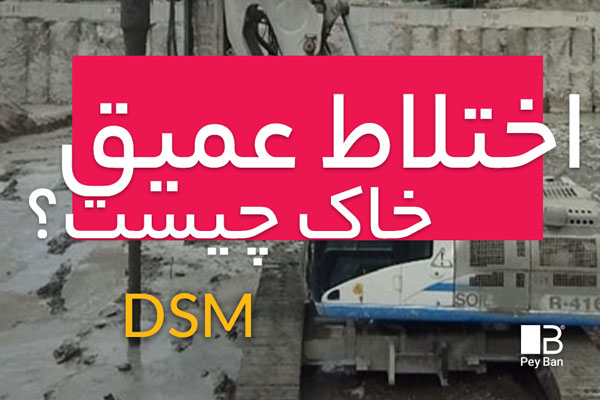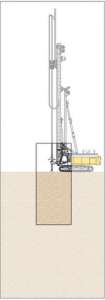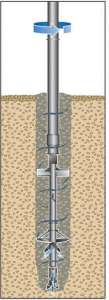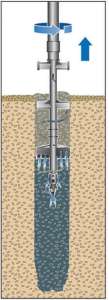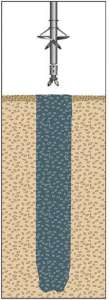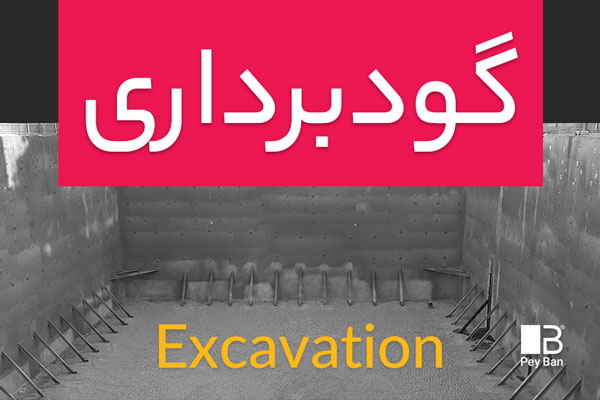What is Deep Soil Mixing (DSM)?
Deep Soil Mixing (DSM) is a soil improvement and stabilization method in which additives such as cement, lime, or fly ash are mechanically mixed with the in-situ soil to enhance its engineering properties. This technique involves deep drilling into the soil and injecting stabilizing agents into the soft and weak soil. Through this process, the mixture of soil and additives turns into a solid and resilient matrix that can increase bearing capacity and reduce ground settlement. The DSM method is commonly used in projects such as urban construction, ports, dams, and other underground structures.
History and Development of Deep Soil Mixing in Geotechnical Engineering
The Deep Soil Mixing (DSM) method was first developed in Japan during the 1960s. Japanese engineers adopted this technique for improving soft and sedimentary soils and enhancing ground stability in construction projects. After initial successes in Japan, the method quickly gained attention in other countries, including European countries and the United States, and became recognized as an effective and reliable method for improving weak soils.
In the 1970s, technological advancements and the development of specialized machinery for deep soil mixing led to its broader application in large-scale civil and industrial projects. Over time, more advanced technologies were developed for deep soil mixing, including the use of new additives and more sophisticated techniques for quality control and precision in operations.
During the 1980s and 1990s, extensive research was conducted to optimize mixing processes and develop more effective additives. These studies resulted in improved performance and reduced execution costs, making deep soil mixing a popular choice for soil improvement worldwide.
Today, the DSM method is recognized as a standard technique for stabilizing and improving weak soils in many countries. The method continues to evolve, with researchers and engineers seeking new techniques and advanced materials to enhance efficiency and reduce costs. In Iran, the use of this method in various construction projects and the improvement of soft, settlement-prone soils, particularly in seismically active regions, is increasingly common.
Overview of the Deep Soil Mixing (DSM) Method
The DSM method is a ground improvement technique where weak and soft soil is mixed on-site with one or more additives, such as cement, lime, fly ash, or other chemicals, to improve the soil’s engineering properties. The goal of this method is to increase the soil’s bearing capacity, reduce settlement, and enhance the stability of the ground against lateral forces like earthquakes.
The DSM process includes the following steps:
- Drilling and Mixing: In this stage, special equipment is used to drill vertically into the soil, while simultaneously injecting and mixing additives with the soil. This operation can be performed mechanically (using rotary mixing tools) or by high-pressure injection.
- Injection of Additives: Depending on the type of soil and environmental conditions, the selected additives are added to the soil. These additives may include cement, lime, fly ash, or other chemicals that help increase the soil’s strength and stability.
- Compaction and Consolidation: After mixing the soil and additives, the resulting mixture is placed in layers within the soil and compacted to ensure proper bonding and consolidation. This step ensures that the improved soil has sufficient strength to bear the imposed loads.
This method is typically used in large-scale construction projects such as buildings, bridges, tunnels, dams, and marine structures. It is also highly effective in areas with soft and sedimentary soils or in seismic regions where soil reinforcement and liquefaction prevention are needed.
The advantages of the DSM method include rapid soil strength enhancement, reduced improvement time and costs, and flexibility in design and execution. However, this method may require specialized equipment and expertise, and it might have higher initial costs compared to some other methods.
Advantages and Disadvantages of the Deep Soil Mixing (DSM) Method
Advantages:
- Improved Bearing Capacity: DSM significantly increases the bearing capacity of weak soils, which is particularly important in projects requiring construction on soft and sedimentary grounds.
- Reduced Ground Settlement: This method can significantly reduce ground settlement, which is crucial for structures sensitive to deformation and settlement, such as tall buildings, bridges, and tunnels.
- Seismic Stability: DSM can enhance ground resistance to seismic forces and reduce the risk of soil liquefaction in earthquake-prone areas.
- Design Flexibility: Due to its ability to combine with various additives and improve different types of soils, DSM offers high flexibility in design and implementation.
- Environmental Compatibility: In many cases, the additives used in DSM, such as cement and lime, have minimal environmental impacts and help minimize the release of harmful substances into the environment.
- Rapid Execution: The DSM method can be executed quickly, especially when experienced equipment and workforce are available.
Disadvantages:
- High Cost: One of the main disadvantages of DSM is its high cost. The use of specialized equipment and the need for additives may increase the initial project costs.
- Requirement for Specialized Equipment and Expertise: Implementing the DSM method requires specific machinery and technical knowledge. Lack of access to suitable equipment or experienced labor can pose challenges to project execution.
- Sensitivity to Environmental Conditions: This method can be affected by environmental conditions such as soil type, groundwater level, and ambient temperature. In some cases, adjustments and changes in additives or execution methods may be necessary.
- Limitations in Depth and Scope: While DSM is suitable for many applications, it may have limitations at very deep depths or in conditions where soil layers are highly variable.
- Quality Control: Maintaining and controlling the quality of the soil-additive mixture throughout the project can be challenging. Poor control can lead to issues such as instability or non-uniformity in the mixture.
Given these advantages and disadvantages, the choice of the DSM method should be made carefully, based on the specific needs of each project and the geological conditions of the site.
Comparison of Deep Soil Mixing with Other Soil Improvement Methods
Various methods are available for improving and reinforcing weak soils, each with its own advantages and disadvantages. Here, we compare DSM with some of the other common soil improvement methods:
- Deep Soil Mixing (DSM) vs. Dynamic Compaction:
- Dynamic Compaction: This method involves compacting the soil by dropping heavy weights onto the surface to densify the underlying soil.
- Advantages: Relatively low cost, high execution speed, suitable for non-cohesive and granular soils.
- Disadvantages: Limited compaction depth and not effective for clayey or highly moist soils. This method may also cause vibrations and damage to nearby structures.
- DSM:
- Advantages: Suitable for various soils, including clayey and sedimentary soils, capable of increasing bearing capacity and reducing settlement, with minimal vibrations and environmental impact.
- Disadvantages: Higher cost, requires specialized equipment and expertise.
- Deep Soil Mixing vs. Grouting:
- Grouting: In this method, cement grout or chemicals are injected into the soil to fill voids and increase soil strength.
- Advantages: Controllable and adjustable injection materials, suitable for porous soils and underground structures, minimal soil displacement.
- Disadvantages: High cost, requires specialized equipment, limited volume and spread of injected materials.
- DSM:
- Advantages: Creates a strong and homogeneous matrix of soil and additives, suitable for non-porous and clayey soils.
- Disadvantages: Higher cost, limited depth and scope compared to some injection methods.
- Deep Soil Mixing vs. Stone Columns:
- Stone Columns: This method involves installing stone columns in the soil to improve its engineering properties.
- Advantages: Increases bearing capacity and reduces settlement, suitable for soft and sedimentary soils.
- Disadvantages: Limited depth and type of soil (unsuitable for cohesive soils), requires specialized machinery, and may cause environmental damage.
- DSM:
- Advantages: Suitable for various soils, increases resistance and stability against earthquakes, reduces the risk of liquefaction.
- Disadvantages: Higher cost, requires specialized equipment and skilled labor.
- Deep Soil Mixing vs. Soil Nailing:
- Soil Nailing: In this method, steel nails are driven horizontally or inclined into the soil to increase its stability.
- Advantages: Suitable for reinforcing earth walls and excavations, lower cost compared to some other methods.
- Disadvantages: Limited soil type and depth, requires precise installation and long-term maintenance.
- DSM:
- Advantages: Increases soil strength both vertically and horizontally, can be combined with other improvement methods.
- Disadvantages: Higher cost and requires more expertise.
Conclusion:
Deep Soil Mixing is an advanced ground improvement method with numerous advantages, including enhanced bearing capacity, reduced settlement, and seismic stability. However, this method has higher costs compared to some other improvement techniques and requires specialized equipment and skilled labor. The best choice for soil improvement should be based on the specific needs of the project, soil type, environmental conditions, and available budget.
Applications of Deep Soil Mixing
Ground Improvement for Construction Projects
Deep Soil Mixing (DSM) is an effective and advanced method for soil improvement and stabilization, widely used in construction projects. This technique can significantly enhance the quality and stability of the ground, contributing to the successful execution of construction projects. Below are some applications of DSM in ground improvement for construction projects:
- Increase in Soil Bearing Capacity: One of the most important applications of DSM is increasing the bearing capacity of weak and soft soils. This is crucial for heavy constructions such as tall buildings, bridges, and industrial structures that require strong and stable foundations. By using this method, the mixture of soil and additives like cement and lime forms a solid and resilient matrix capable of bearing heavy loads.
- Reduction of Ground Settlement: Ground settlement can damage buildings and structures, potentially leading to their collapse. DSM can significantly reduce ground settlement by creating a stable and dense layer. This feature is particularly important for structures sensitive to deformation and settlement, such as residential, office, and commercial buildings.
- Improvement of Slope and Excavation Stability: In construction projects requiring deep excavation or stabilization of soil slopes, DSM can enhance the stability of walls and slopes. This method strengthens unstable soils, reducing the risk of soil slippage and collapse, thus improving safety on construction sites.
- Construction and Stabilization of Underground Structures: For the construction of underground structures like parking lots, tunnels, and subways, soil improvement and increasing its resistance to lateral forces and earthquakes is necessary. DSM can increase the soil’s resistance to lateral forces and surface changes, reducing the risk of liquefaction in seismic areas.
- Soil Improvement in Areas with High Groundwater Levels: In areas with high groundwater levels, soils may be saturated and soft, causing significant challenges for construction. DSM can stabilize saturated soils and reduce their permeability, improving ground conditions and enabling construction in these areas.
- Reduction of Environmental Impacts: The use of DSM can reduce the need for transportation and use of external materials, as it utilizes the soil available on-site. This can help reduce transportation costs and environmental impacts from the extraction and transportation of construction materials.
Use in Marine Structures
Deep Soil Mixing (DSM) is an advanced and effective method for soil improvement and stabilization, with wide applications in the construction and stabilization of marine structures. Marine structures such as ports, docks, breakwaters, and offshore oil platforms are usually built on soft and sedimentary soils that require reinforcement and improvement. DSM can be highly effective in enhancing the stability and performance of these structures under harsh marine conditions. Below are some applications of DSM in marine structures:
- Stabilization and Strengthening of the Sea Bed Soil: Many marine structures are built on soft and sedimentary soils, which cannot withstand heavy loads and lateral pressures without proper improvement. DSM stabilizes and strengthens these soils, providing a resilient foundation for marine structures and preventing settlement and displacement of the structures.
- Creation of Strong and Stable Foundations: For the construction of docks and ports, strong and stable foundations are necessary to withstand heavy loads and wave impacts. DSM forms a resilient matrix of soil and additives, providing strong and stable foundations for these structures. This method can also prevent non-uniform settlement and deformation of the foundation.
- Reduction of Soil Liquefaction Risk: Soil liquefaction is one of the major problems in coastal and marine areas that can lead to the destruction of marine structures. DSM can significantly reduce the risk of soil liquefaction by increasing soil density and strength, thereby enhancing the stability of marine structures against earthquakes and severe waves.
- Construction of Breakwaters and Coastal Barriers: Breakwaters and coastal barriers are built to protect coastlines and marine structures from strong waves and currents. DSM can help stabilize the foundations of these structures, preventing their displacement and destruction in adverse weather conditions.
- Soil Improvement for Offshore Oil and Gas Structures: Offshore oil and gas structures require highly stable and resilient grounds to operate under harsh marine conditions and heavy loads. DSM can improve the mechanical and hydraulic properties of the seabed soil, providing suitable conditions for the installation and operation of these structures.
- Erosion Control and Coastal Stabilization: In coastal areas where soils are prone to rapid erosion, DSM can reduce erosion and increase the stability of the coastlines by stabilizing and strengthening the soils. This is particularly important for protecting coastal infrastructure and preventing erosion-related damage.
In the Construction of Tunnels and Dams
Deep Soil Mixing (DSM) is one of the effective and advanced methods for soil improvement and stabilization, widely used in large infrastructure projects such as tunnels and dams. The construction of these complex structures requires stable and resilient grounds to prevent settlement, deformation, and destruction caused by heavy loads and environmental pressures. Below are some applications of DSM in the construction of tunnels and dams:
- Applications of DSM in Tunnel Construction:
- Ground Stabilization and Settlement Reduction: In tunnel construction projects, ground stabilization and reinforcement are essential to prevent settlement and displacement. DSM can increase the strength and stability of the soil, reducing the risk of unauthorized settlement around tunnels and providing better safety conditions for excavation and construction operations.
- Reduction of Water Infiltration and Tunnel Sealing: In areas with high groundwater levels or water-bearing soils, sealing tunnels and preventing water infiltration into the structure is crucial. DSM can reduce soil permeability and create a resistant barrier, helping prevent water seepage into tunnels and protecting against water damage.
- Stability of Tunnel Walls and Floors: During tunnel excavation, the stability of the walls and floors is necessary to prevent collapse and ensure safe working conditions for workers. DSM can reinforce unstable soils and increase their shear strength, ensuring the stability of tunnel walls and floors, and preventing collapse and destruction.
- Control of Soil Liquefaction in Seismic Areas: In areas where there is a risk of earthquakes and soil liquefaction, DSM can increase soil density and strength, reducing the risk of liquefaction and ensuring the stability of tunnels during earthquakes.
- Applications of DSM in Dam Construction:
- Increase in Stability and Prevention of Dam Settlement: Building dams on soft and weak soils may lead to settlement and instability of the dam. DSM can improve and reinforce the soil beneath the dam, preventing unauthorized settlement and unwanted deformation, and increasing the overall stability of the structure.
- Prevention of Water Seepage from Beneath the Dam: One of the key challenges in dam construction is preventing water seepage from beneath the dam and maintaining its efficiency. DSM can reduce soil permeability and create a waterproof layer, helping prevent water seepage and enhancing dam performance.
- Stabilization of Slopes Around and Downstream of the Dam: Stabilizing the slopes around and downstream of the dam is crucial to prevent landslides and destruction. DSM can reinforce and stabilize these slopes, reducing the risk of landslides and destruction, and preventing damage to dam structures.
- Erosion Control and Stability of Dam Foundations: In earth and rockfill dams, erosion of the dam foundations can reduce stability and lead to the destruction of the dam. DSM can reinforce the foundation soils and reduce erosion, helping maintain stability and increase the dam’s service life.
- Enhancement of Dam Resistance to Earthquakes: In seismic areas, the resistance of dams to earthquake forces and preventing collapse is critical. DSM can increase the density and strength of the underlying and surrounding soils, improving the dam’s stability against earthquakes.
Soil Stabilization in Seismic Areas Using Deep Soil Mixing
Deep Soil Mixing (DSM) is an effective method for soil improvement and stabilization in seismic areas. In this method, unstable and weak soils are mixed with additives such as cement, lime, or other stabilizers to enhance the engineering properties of the soil. Soil stabilization in seismic areas is of particular importance, as these areas are at high risk of soil liquefaction and ground instability during earthquakes. Below are some applications and advantages of DSM for soil stabilization in seismic areas:
- Reduction of Soil Liquefaction Risk: Soil liquefaction is one of the greatest hazards in seismic areas, which can lead to the destruction of structures and infrastructure. Liquefaction occurs when saturated soils are subjected to seismic loads, causing pore water pressure within the soil to increase, making the soil temporarily behave like a liquid. DSM can reduce pore water pressure by increasing soil density and cohesion, thereby enhancing soil resistance to liquefaction.
- Increase in Bearing Capacity and Ground Stability: Increasing bearing capacity and ground stability is another advantage of DSM in seismic areas. By mixing unstable soils with additives, the mechanical properties of the soil are improved, increasing its resistance to seismic forces. This is particularly important for structures sensitive to settlement and deformation, such as tall buildings, bridges, and tunnels.
- Improvement of Slope and Coastal Stability: The stability of slopes and coastlines in seismic areas is of great importance, as landslides and slope failures can lead to the destruction of structures and infrastructure. DSM can strengthen and stabilize unstable soils in slopes and coastlines, reducing the risk of landslides and slope failures, and enhancing the stability of these areas against earthquakes.
- Reduction of Uneven Settlements: Uneven settlements during earthquakes can lead to the destruction of structures and roads. DSM can create a homogeneous and resilient layer of stabilized soil, minimizing uneven settlements and preventing damage to structures caused by unwanted deformations.
- Creation of Seismic Barriers and Waterproof Structures: In infrastructure projects such as dams and levees, preventing water seepage and ensuring the stability of dams against earthquakes is important. DSM can be an effective method for creating seismic barriers and reducing the risk of water seepage from beneath structures, improving their performance during earthquakes.
- Reduction of Vibration and Shaking in Buildings and Infrastructure: Reducing vibration and shaking during earthquakes is critical to maintaining the stability of buildings and infrastructure. DSM can reduce ground vibration and shaking by creating a strong and resilient layer, preventing the transfer of these forces to upstream structures.
Materials and Equipment Used in Deep Soil Mixing
Deep Soil Mixing (DSM) as an effective method for soil improvement and stabilization requires the use of specific additives and equipment. In this method, unstable and weak soils are reinforced with chemical and mechanical materials to enhance their engineering properties. Below is an overview of the types of additives and stabilization materials, as well as the equipment and machinery used in DSM:
- Types of Additives and Stabilization Materials:
- Cement:
- Description: Cement is one of the common additives in DSM used to strengthen and stabilize weak soils.
- Properties: Increases shear strength and bearing capacity of the soil, reduces permeability.
- Applications: Suitable for granular and clay soils.
- Lime:
- Description: Lime is another additive used to improve the properties of clay soils and increase their cohesion.
- Properties: Improves the physical and chemical properties of the soil, increases compactability.
- Applications: Suitable for clay soils and soils with high moisture content.
- Chemical Additives (Polymers and Resins):
- Description: Polymers and resins are used to improve the mechanical properties of the soil and increase its strength.
- Properties: Increases cohesion and reduces soil permeability.
- Applications: Used in specific conditions and for improving the properties of certain soils.
- Cement-Lime Grout:
- Description: A combination of cement and lime that is injected into the soil as a grout.
- Properties: Combines the advantages of cement and lime to improve soil properties.
- Applications: Suitable for weak soils and soil structure improvement.
- Other Additives (Supplementary Soils, Mineral Additives):
- Description: Mineral additives and supplementary soils can be used to reinforce soil properties and improve its physical characteristics.
- Properties: Enhances soil cohesion and structure.
- Applications: Depending on the specific project needs and soil type.
- Cement:
- Equipment and Machinery Used:
- Soil Mixing Machines:
- Description: These machines are used to mix soil with additives and typically include specialized equipment for drilling and mixing.
- Properties: Capable of drilling and mixing at various depths, high capacity.
- Models: Machines with rotary shafts, hydraulic and mechanical systems.
- Drilling Rigs:
- Description: Drilling rigs are used to bore holes and prepare the ground for DSM.
- Properties: High drilling power, capable of drilling at various depths.
- Models: Drilling rigs with rotary shafts, rigs with specialized bits.
- Grout Pumps:
- Description: Pumps are used to inject cement grout, lime, or other additives into the soil.
- Properties: Capable of pumping materials with different viscosities, high precision in injection.
- Models: Piston pumps, rotary pumps.
- Grout Mixers:
- Description: Mixers are used to combine additives with water to produce grout suitable for soil injection.
- Properties: High capacity, capable of uniform mixing.
- Models: Horizontal and vertical mixers.
- Measurement and Control Systems:
- Description: Systems and sensors are used to control the quality of mixing and monitor the process.
- Properties: High accuracy, capable of measuring various parameters such as viscosity and pressure.
- Models: Digital and analog systems.
- Soil Mixing Machines:
Steps for Implementing Deep Soil Mixing
Deep Soil Mixing (DSM) is an effective method for improving weak and unstable soils, involving several key stages. These steps are systematically carried out to ensure that the soil is properly reinforced and stabilized. Below, the main steps for implementing DSM are described in detail:
- Site Preparation
- Site Assessment and Evaluation:
- Description: Before starting the work, the condition of the ground and the characteristics of the soil must be assessed. This evaluation includes examining the type of soil, the depth of different layers, and the groundwater level.
- Actions: Soil testing, assessment of environmental and mechanical conditions.
- Planning and Design:
- Description: Based on the data obtained, the planning and design of the DSM operation are conducted.
- Actions: Designing coordinate maps, determining the depth and spacing of the boreholes, selecting appropriate additives.
- Preparation of Equipment and Materials:
- Description: The necessary equipment and materials for the operation are prepared.
- Actions: Inspection and setup of machinery, procurement of additives (cement, lime, chemicals), and preparation of the grout.
- Ensuring Access to the Site:
- Description: Ensuring proper access to the project site for equipment and machinery.
- Actions: Preparing transportation routes and workspace.
- Site Assessment and Evaluation:
3. Injection of Stabilizing Materials
Preparation and Injection of Grout:
Explanation: Cement grout, lime, or chemical materials are prepared and injected into wells or holes.
Actions: Use grout pumps for injecting materials, control pressure, and monitor the injection rate.
Control and Monitoring of the Injection Process:
Explanation: Monitor the grout injection and ensure its uniform distribution within the soil.
Actions: Use measurement and control systems, record relevant data.
Examination of Reaction and Mixing:
Explanation: Examine how the additives react with the soil and ensure improvement in soil properties.
Actions: Conduct quality tests and process control.
4. Compression and Compaction
Soil Compression and Compaction:
Explanation: After injecting stabilizing materials, the soil must be compressed and compacted to achieve the desired properties.
Actions: Use compression and compaction equipment, check the soil’s density and strength.
Final Control and Evaluation:
Explanation: Perform a final evaluation of the soil properties after compression and compaction to ensure compatibility with the project requirements.
Actions: Conduct final tests on the improved soil, review test reports, and assess the final condition.
Preparation for Subsequent Construction Phases:
Explanation: Ensure that the stabilized soil is sufficiently stable and resistant to be ready for the next stages of construction.
Actions: Prepare the site for the installation of structures, verify compliance with design specifications.
